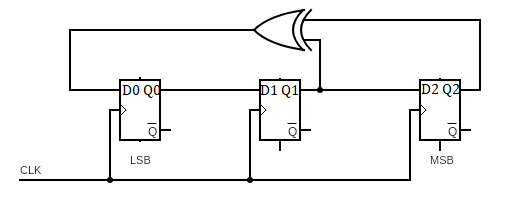The diagram of FF is:

According to figure, we can write next state as:
$Q_{0N}=Q_1 \oplus Q_2, Q_{1N}=Q_0,Q_{2N}=Q_1$
Transition table can be given as:
| Q2 |
Q1 |
Q0 |
Q2N |
Q1N |
Q0N |
| 0 |
0 |
0 |
0 |
0 |
0 |
| 0 |
0 |
1 |
0 |
1 |
0 |
| 0 |
1 |
0 |
1 |
0 |
1 |
| 0 |
1 |
1 |
1 |
1 |
1 |
| 1 |
0 |
0 |
0 |
0 |
1 |
| 1 |
0 |
1 |
0 |
1 |
1 |
| 1 |
1 |
0 |
1 |
0 |
0 |
| 1 |
1 |
1 |
1 |
1 |
0 |
$4Q_2 + 2Q_1+Q_0$ is simply the decimal equivalent of state. Now, transition diagram can be drawn from above table as:

Correct State Sequence: 1,2,5,3,7,6,4.
Option (B) is correct answer.